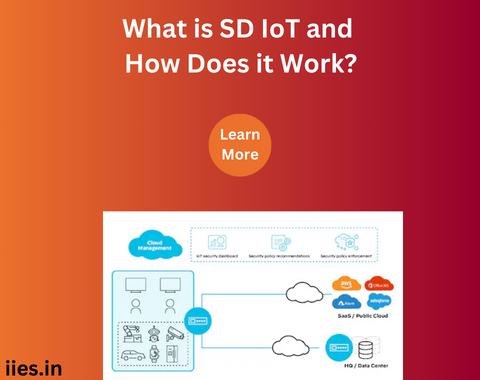
In the rapidly evolving landscape of technology, the amalgamation of Secure Digitalization (SD) and the Internet of Things (IoT) has emerged as a powerful force, revolutionizing the way we interact with the digital world. This synergy holds immense potential for innovation, efficiency, and connectivity, but it also raises critical concerns about security and privacy. In this article, we will delve into the intricacies of SD in IoT, exploring the challenges and solutions in safeguarding our digital future.
Secure Digitalization (SD) refers to the integration of security measures into digital processes and systems to protect data, infrastructure, and communication channels. In the context of the Internet of Things (IoT), SD becomes particularly crucial. This interconnected web of devices presents an expanded attack surface, making robust security measures essential.
Secure Digitalization (SD) refers to the integration of security measures into digital processes and systems to protect data, infrastructure, and communication channels. In the context of the Internet of Things (IoT), SD becomes particularly crucial. This interconnected web of devices presents an expanded attack surface, making robust security measures essential.
1. Security Challenges in IoT
The proliferation of IoT devices has brought about a host of security challenges. The sheer volume and diversity of connected devices make it difficult to enforce uniform security standards. Common security challenges in IoT include:
a. Device Vulnerabilities: Many IoT devices are resource-constrained, lacking the computational power and memory required for robust security protocols.
b. Data Privacy Concerns: IoT devices often collect sensitive data, raising concerns about how this information is stored, processed, and shared.
c. Interoperability Issues: The heterogeneity of IoT devices may result in interoperability issues, making it challenging to implement standardized security measures across different platforms.
d. Lack of Update Mechanisms: Some IoT devices may lack a seamless update mechanism, leaving them exposed to known vulnerabilities for extended periods.
e. Inadequate Authentication: Weak or compromised authentication mechanisms can lead to unauthorized access, potentially compromising the integrity of the entire IoT ecosystem.
2. The Role of Secure Digitalization in Mitigating IoT Security Risks
a. End-to-End Encryption: Implementing end-to-end encryption ensures that data remains confidential throughout its journey from the IoT device to the cloud or other endpoints. This measure protects against eavesdropping and unauthorized access.
b. Authentication and Access Control: Robust authentication mechanisms, such as multi-factor authentication, help verify the identity of devices and users, preventing unauthorized access. Access control measures limit the actions that each device or user can perform within the IoT ecosystem.
c. Security by Design: Integrating security into the design phase of IoT devices is crucial. This includes conducting thorough security assessments, addressing potential vulnerabilities, and building devices with security in mind from the outset.
d. Regular Software Updates: Establishing a reliable mechanism for regular software updates is vital for addressing newly discovered vulnerabilities. Manufacturers should provide timely updates to patch security flaws and enhance the overall resilience of IoT devices.
e. Network Segmentation: Segmenting the IoT network helps contain potential breaches. By dividing the network into isolated segments, the impact of a security incident can be confined to a specific subset of devices, preventing it from spreading across the entire ecosystem.
3. Emerging Technologies Enhancing SD in IoT
a. Blockchain Technology: The decentralized and tamper-resistant nature of blockchain makes it a promising technology for enhancing the security of IoT. It can be used to establish a secure and transparent ledger of device interactions, reducing the risk of data tampering.
b. Machine Learning and Artificial Intelligence: These technologies play a crucial role in detecting and mitigating security threats in real-time. By analyzing patterns and anomalies in data, machine learning algorithms can identify suspicious activities and trigger preventive measures.
c. Edge Computing: Processing data closer to the source (at the edge) reduces the latency associated with sending information to centralized cloud servers. This not only improves the efficiency of IoT systems but also enhances security by minimizing the exposure of sensitive data during transit.
Privacy in the Era of IoT
Privacy concerns have become a focal point in the discussion surrounding IoT, as the vast amount of data generated by connected devices often includes personal and sensitive information. Secure Digitalization plays a pivotal role in addressing these concerns by incorporating privacy-preserving practices:
a. Data Minimization: Implementing the principle of data minimization involves collecting only the necessary information to fulfill the intended purpose. This reduces the potential impact of a data breach and ensures that users’ privacy is prioritized.
b. User Consent and Transparency: Secure Digitalization emphasizes the importance of transparent data practices and obtaining explicit user consent. Users should be informed about what data is being collected, how it will be used, and have the option to opt out if they choose.
c. Anonymization and Pseudonymization: Protecting individual identities through anonymization and pseudonymization techniques adds an extra layer of security. By replacing personally identifiable information with anonymous or pseudonymous identifiers, the risk of unauthorized identification is mitigated.
Regulatory Landscape and Compliance
Governments and regulatory bodies are recognizing the need to address the security and privacy challenges posed by IoT. Secure Digitalization aligns with and supports compliance with various regulations, such as the General Data Protection Regulation (GDPR) in Europe and the California Consumer Privacy Act (CCPA) in the United States. Manufacturers and service providers must adhere to these regulations to ensure legal and ethical use of IoT technologies.
As the world becomes increasingly interconnected through the Internet of Things, the need for robust Secure Digitalization practices has never been more critical. Balancing innovation with security is a complex challenge, but with the right measures in place, the potential benefits of IoT can be fully realized while safeguarding against evolving threats. As we navigate the future of digitalization, a collaborative effort involving manufacturers, policymakers, and end-users is essential to ensure a secure and resilient IoT ecosystem.
Indian Institute of Embedded Systems – IIES